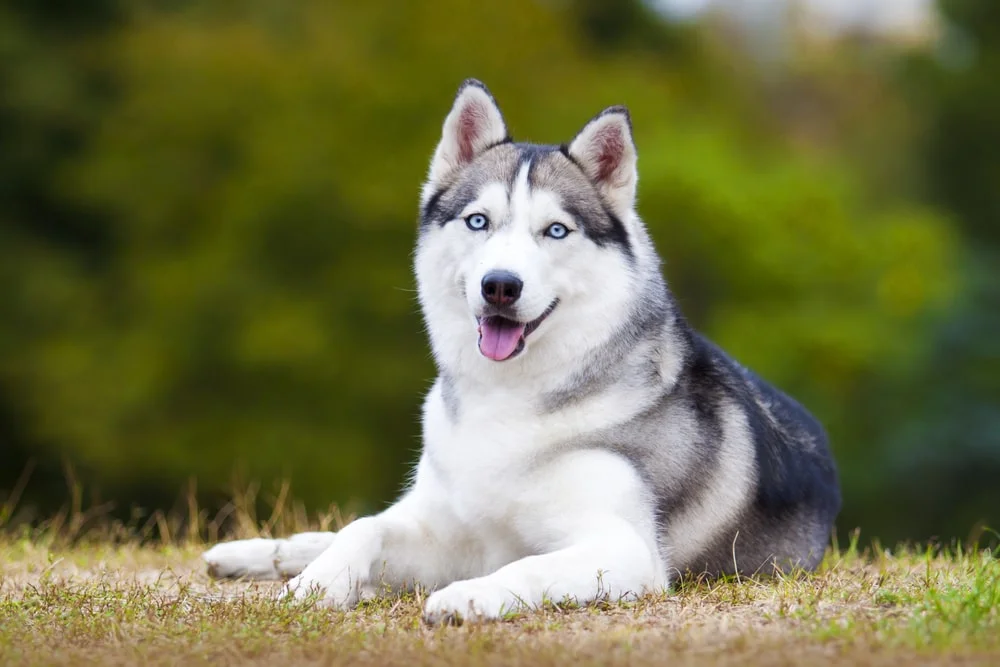BREED SPOTLIGHT
Breed Spotlight: Siberian Husky
Siberian Husky Quick Stats
LIFESPAN:
12-14 years
WEIGHT:
35-60 lbs
HEIGHT:
20-23.5 inches
DO I SHED?
Yes
Personality: Affectionate, friendly, intelligent
Health Problems: Eye issues, thyroid problems, hip dysplasia
Siberian Huskies: How Do I Look?
Perhaps there’s no more iconic example of a sled dog than the Siberian husky. Many people will immediately recognize them for their fluffy bodies, erect ears, brush tails, and graceful movements.1,2 Siberian huskies have a long history as working dogs, but they’ve become popular pets due to their friendliness and intelligence.1
Coat type and colors
A Siberian husky’s thick, double coat often allows them to better tolerate cold, arctic temperatures.3 The undercoat is soft and dense, while the “guard hairs” of the outer coat are straight and somewhat smooth — but neither harsh nor standing straight off from the body.2
Coats may be solid, contain multiple shades, or include white markings. They can also have asymmetrical patterns, such as piebald and saddle-back.1,2 Common colors include black, gray, agouti, sable, red, and white.2
Ears
The breed has erect, triangular ears that sit high on the head and stick straight up.2
Shedding and grooming
While Siberian huskies are a relatively clean breed — they often carry very little odor and only need a few baths — they do shed their undercoats twice a year.1,4 It’s a good idea to brush your pet weekly to help remove any old fur.1
Drooling level
Generally, Siberian huskies aren’t excessive droolers.1 If yours does begin to drool a lot, it may indicate a developing health issue. Still, drooling in itself isn’t necessarily a bad thing.
Siberian Husky: Personality Traits
What My Adoption Bio Would Say:
My ancestors were first bred in the arctic isolation of Northeast Asia, where they developed their reputations as great companions and hardworking sled dogs. My breeding makes me strong, graceful, and agile — although, I can sometimes be a little energetic and mischievous. Still, I love being around kids and visitors, and I’ll make a great member of your family.1
Behavior
Siberian huskies are generally friendly and gentle.1 They can also be alert, outgoing, playful, and eager — however, they don’t make the best watchdogs.1,2
Trainability
Like all dogs, Siberian huskies can benefit from early socialization and obedience training, but they may be challenging to train due to their strong will.1
Exercise needs
Because of their history as sled dogs, Siberian huskies can be quite athletic and high-energy, meaning they need regular exercise. The American Kennel Club (AKC) recommends keeping your dog within a fenced-in area so they have room to run. You should also keep them on a leash when venturing out.1 The breed also tends to like mental stimulation, so they’re often happy when given a function to perform.1,2
Good with kids?
Generally, Siberian huskies are great around kids and can make good family pets.1 However, because the breed can be strong-willed, it’s a good idea to supervise them around children.1,4
Good with other pets?
Siberian huskies are social dogs, and they usually get along well with other dog breeds. However, they’re prone to chasing small animals and have a high prey drive.1,5 As a result, they may kill small animals like birds, lizards, squirrels, and guinea pigs, and they may not be suitable around cats and smaller dogs.5 It’s recommended that dogs always be supervised during interactions and introductions with other dogs.1
Barking level
This breed howls, sings, barks, and is often very vocal in general. That said, proper training can help teach your Siberian husky to use their inside voice.4
Siberian Huskies: A History
As their name suggests, Siberian huskies originated in the vast expanses and often frigid climates of Siberia in Northeast Asia. The Chukchi people developed the breed as both a companion and a working dog that could haul light loads over long distances. Because the Chukchi were an isolated people, they were able to maintain the purity of their breed over many generations. Today’s Siberian huskies are descendants of those long-ago canines.1
Siberian huskies became more well-known to the public when they began winning sled-dog races in the early 20th century. However, the breed made international headlines in 1925, when a diphtheria epidemic ravaged Nome, Alaska. A team of Siberian huskies transported a lifesaving serum more than 650 miles in 5 days during the “serum run,” earning their breed enduring popularity. The team’s lead dog, Balto, is one of the most beloved canine heroes in history. Even today, dog sled races using teams of Siberian huskies remain a popular sport.1
5 Siberian Husky Health Problems
Although the Siberian husky is generally a healthy breed, they aren’t immune to various health issues, notably several eye-related problems.1,4 A few conditions to watch out for include:4
- Cataracts: This condition of the eye occurs when an eye’s lens hardens and begins to affect the vision.
- Progressive retinal atrophy (PRA): PRA occurs when an eye’s retina begins to deteriorate. It may be more common in males.
- Corneal dystrophy: An opaque, white area may develop on the cornea of a dog’s eye. Advanced cases may cause pain and ulceration that require treatment.
- Hypothyroidism: The dog’s thyroid gland may not produce enough thyroid hormone, which can cause the dog’s metabolism to slow and trigger other issues.
- Hip dysplasia: If a dog’s hip joint doesn’t develop properly, they may experience a loose joint that leads to arthritis and further problems.
Is Paying Your Dog’s Vet Bills Getting Hairy?
How Pet Insurance May Help Siberian Huskies
A focus on cataracts
Siberian huskies are susceptible to cataracts, and the condition may develop in dogs as young as 6 – 18 months old.4 Conditions like diabetes, various eye injuries, and other factors may cause cataracts to develop in one or both eyes. Like cataracts in humans, dog cataracts can lead to total blindness in one or both eyes if left untreated.4 Cataract surgery is the only certain way to treat the condition for the time being.
Cataract surgery is often relatively expensive — the cost may range from $2,700 – $4,000 — and involves replacing the affected lens with a clear, artificial one. Although the cost may seem steep, the operation has a long-term success rate of 85% – 90%. The good news is if you have pet insurance, your policy may help cover many of the costs associated with diagnosing and treating the condition. However, it’s a good idea to get coverage while your dog is young, as cataracts may fall under a pre-existing condition exclusion if you wait to get a policy after it develops.
A focus on hypothyroidism
The Siberian husky is one of several breeds most commonly diagnosed with hypothyroidism. Affected dogs may experience lethargy, weight gain, various problems with their skin and coats, and other symptoms. Although the condition is incurable, a dog’s prognosis is quite good with proper treatment.6
To diagnose hypothyroidism, your veterinarian will usually run a series of blood tests.6 Then, they’ll likely prescribe medication — often levothyroxine, a synthetic hormone replacement — as treatment. The dog will have to take the medication for the rest of their life.7
Like with cataracts, pet insurance may help cover costs related to your Siberian husky’s hypothyroidism. Remember, it’s important to get coverage before your pet receives a diagnosis, as the illness may fall into a pre-existing condition exclusion otherwise.
Learn more about how MetLife Pet Insurance may be able to help protect your Siberian husky by reading our guide, “How Pet Insurance Works.” If you’re ready to get started, you can also get a free custom quote today.
Help Protect Your Dog at Any Age






